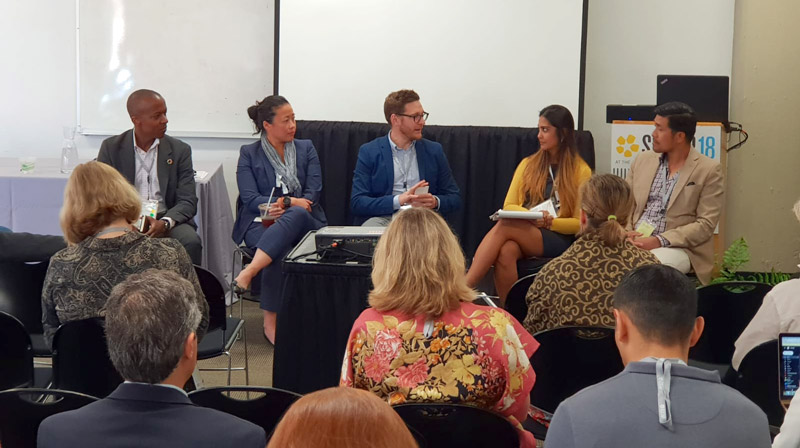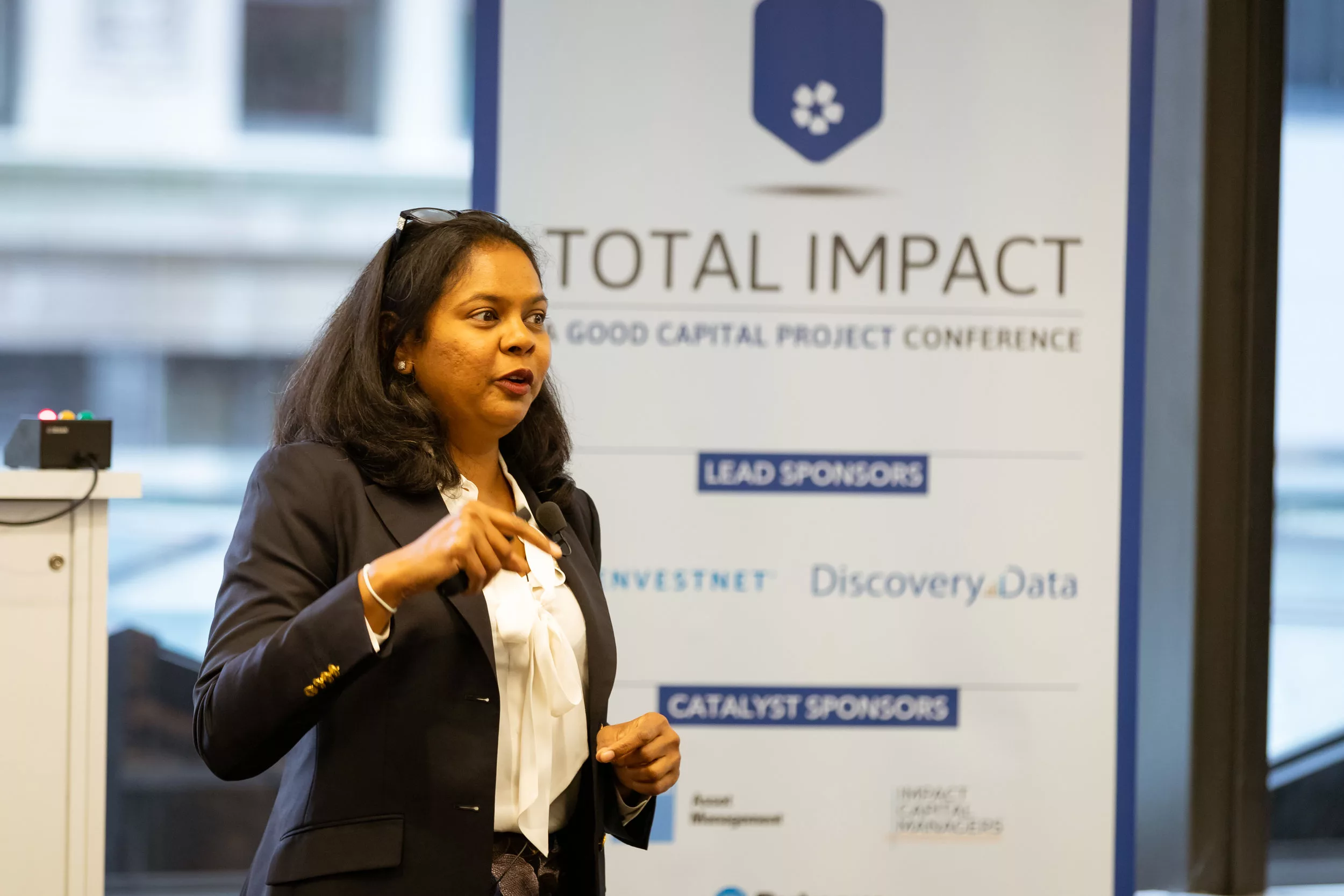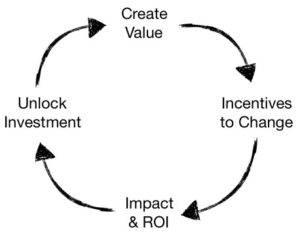To bring more of the SOCAP Community into the conversation, we invited SOCAP18 session leaders, speakers, and attendees to share their major insights and takeaways from the conference.
The Fisheries Imperative
We use a single word to represent thousands of species that we still hunt en masse, “fish.” Despite its complexity and lack of predictability, fish are vitally important to global food security and climate change resilience. Investors, however, have historically been skittish on funding sustainable development in fisheries. This has to change. Blended finance and supply chain value may just be the drivers to bring about this change.
If you don’t think fish affects you, think again. Fish is the primary animal protein source of over 2.5 billion people globally, particularly in island and coastal nations, many of which produce goods you enjoy on a daily basis. Fish also sequester carbon, protecting against global warming and keeping natural storm defenses like coral reefs healthy. Life under water is amazing, but it is in trouble. Global fisheries are under incredible pressure from overfishing, climate change and human activities that disrupt feeding and breeding. Left unabated, sustained declines in wild capture fisheries will be catastrophic.
Limited Capital, Weak Incentives
It is our shared imperative to transform fisheries to sustainable production and protect crucial habitats. The good news is that we have a playbook for how to do this. Fisheries scientists and economists have given us the models to inform catch regulations and locate and protect critical habitats. The bad news is that there is a serious lack of capital and incentives in place to fuel this transition. There is simply not enough public and philanthropic capital available, and current models aren’t producing enough value for fishers and the supply chain to warrant their buy-in.
These two problems are intricately tied. More valuable fisheries could attract investment capital that could fuel more sustainable practices, in a virtuous cycle that could regenerate fisheries globally. The next wave of fisheries transformation needs to be rooted in unlocking value in fisheries, and blending capital sources to crowd-in private investment.
Value is Waiting in Supply Chains
The most compelling place to unlock value may be in the supply chain. Seafood loses value quickly. Time is literally money in seafood, as product loses weight from water loss and degrades in composition. By investing in things like inventory management, streamlined supply chains, high-integrity cold chains, and building domestic markets, value can be realized in the short-term. These short-term wins should not be underestimated – they lay the foundation for generating the runway to transition to the real prize – stabilized, well-managed, and in the best cases, rebounding stocks that could generate billions of dollars annually.
Seafood supply chains offer plenty of room to improve, but this hasn’t spurred the flow of investment needed to fund their transition. For a myriad of reasons, fisheries projects are still too risky today to attract capital. Managers are inexperienced, corruption is common, and ease of doing business in many seafood-producing countries remains limited. Projects are often also too small, failing to meet minimal deal sizes investment managers need to move their money.
Intermediaries Increasingly in Focus
Investors need to start thinking less about the lack of current deals and more about project development. While many funds lack the mandate and resources to develop projects directly, they can proactively partner with intermediaries who can package the right deals to meet their needs. The role of intermediaries was raised throughout SOCAP18, with a shifting narrative that is increasingly recognizing their importance as trusted brokers that can identify opportunities, perform due diligence and cultivate high quality projects. This is where concessionary capital can be strategically applied – helping nascent projects to become investment ready, and creating enabling market conditions to help new businesses models thrive.
Strategic Concessions
In its simplest form, technical assistance grants can create enabling market conditions and can help managers and entrepreneurs to hone and test their business models. More sophisticated models will emerge over time, and can take inspiration from agricultural development. For example, foundation grants and development funds could be structured creatively, playing a first-loss role, or providing guarantees for risky investments. Fisheries are at a unique intersection for attracting concessionary capital given the multitude of Sustainable Development Goals at play, including No Poverty, Zero Hunger, Gender Equality, Decent Work and Economic Growth, and Life Under Water to name a few.
To focus on blended finance and supply chain value stands in contrast to an exclusive focus on stock management and certification-based price increases. The fisheries system needs to be viewed as a whole, with equal credence paid to fishers’ livelihoods, supply chain incentives, and deal structuring as is currently focused on good data and governance.
Emerging Case Studies
Future of Fish is applying this approach in the fisheries where it is active, from Chile to Vietnam. We work with partners across multiple domains including NGOs, supply chain businesses, government agencies and diverse funders to identify the right set of interventions to de-risk fisheries for investment, while providing the enabling conditions for good governance, such as data-rich supply chains. There is no silver bullet solution to be consistently applied across these fisheries. While we advocate an initial focus on alternative livelihoods and economic development in Vietnam’s blue swimming crab fishery, for example developing a market for live product in the high-paying tourist market, we are advocating supply chain efficiencies and traceability to reduce illegal fishing in the Chilean hake fishery.
We are not alone in our application of new models. At SOCAP18, a panel was hosted with a diverse set of organizations applying principles of blended finance and supply chain value, including Conservation International Ventures, Akipeo, Lotus Impact and the Walton Family Foundation. Conservation International Ventures seeks to fill the funding gap that often stalls early-stage fishery development projects and novel conservation technologies, and strategically applies development funding to perform market and conservation analyses that inform due diligence. Akipeo is working at the institutional level to structure funds into different levels of subordination to crowd-in private investment for a portfolio of commodities. Lotus Impact takes an entrepreneur-first approach, directing high-potential social entrepreneurs in Vietnam to opportunities that have been mapped for both impact and financial return, using the social and economic development case to secure support from development agencies. The Walton Family Foundation, meanwhile, is applying its philanthropy to create the enabling conditions that allow business solutions to flourish, including solution design and business planning in the Chilean hake fishery.

This panel was held in the spirit of sharing lessons learned early and often. We do not need to wait for a well-established case study to reference what is working and what is not in seafood. For example, the “free money” problem was discussed, where loan providers are competing with grant funders in communities that are highly accustomed to subsidy. This is not a unique problem, and organizations shared best practices on collaborating with grant funders to be more strategic with their capital to scale their impact.
Definitions of Success
In fisheries investment, the definition of success that we seek to achieve may depend on which level you operate. One definition raised on the Blended Finance in Fisheries panel by Akipeo was “IRR Zero.” At the harvest level, in aggregate, large institutions may need to recalibrate expectations for fisheries to break-even, knowing that shifting to sustainable production is a worthwhile impact goal, given their crucial role in food security and ecosystem health. On the ground, the story looks a lot different. Lotus Impact discussed the wealth of opportunity that exists when investors focus on good entrepreneurs seeking to make community-level impact with business models that can disrupt the status quo in food distribution and data management. From an angel investor’s point of view, scalable models that create positive impact are a compelling opportunity to take risk given the opportunity to remove inefficiency and create new value in fisheries.
Take Away
While fisheries are complicated, humans are adept at managing complexity with the right incentives and shared knowledge. By casting a broader net for how fisheries generate value and how funders collaborate, we can set global fisheries a new, scalable path to sustainable production.
Resources
- The Sunken Billions Revisited: Progress and Challenges in Global Marine Fisheries, World Bank
- Principles for Investing in Sustainable Wild-Caught Fisheries
- Blended Finance Volume 1: A Primer for Development Finance and Philanthropic Funders
- Making Sense of Wild Seafood Supply Chains
About the Author
As Blended Finance Lead for Future of Fish, Greg FitzGerald applies his experience as an entrepreneur, strategist and fundraising advisor to design creative models for financing fisheries transformation. Greg has previously founded two environmental analytics companies to illuminate supply chain carbon emissions and waste, has advised executives of publicly listed companies through digital transformation initiatives, and has coached dozens of impact startups from concept through seed funding. Greg holds an MBA (Oxford University), mechatronics systems engineering degree (U. Waterloo), and was sponsored by Google to attend the climate change themed Global Solutions Program at Singularity University to positively impact a billion people in ten years.



